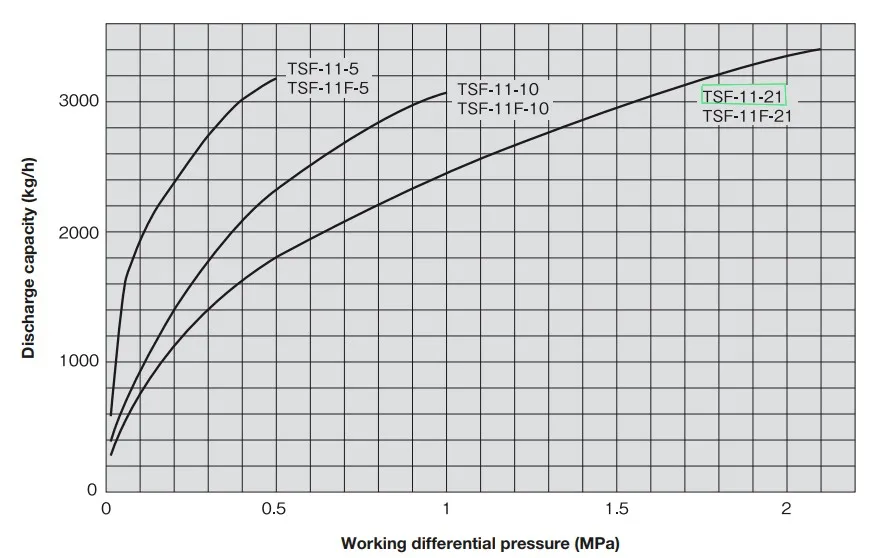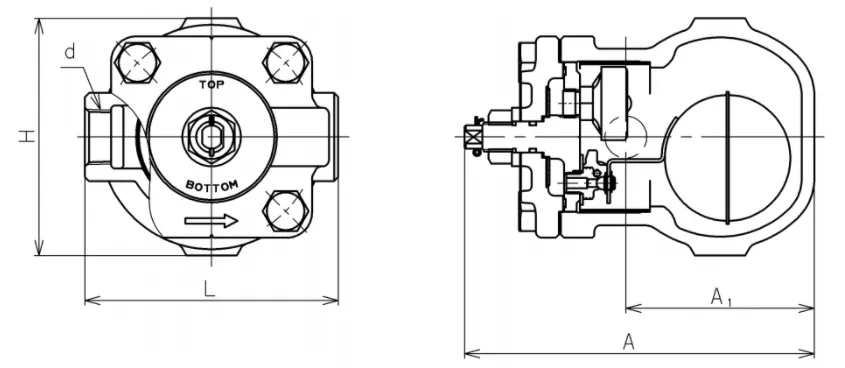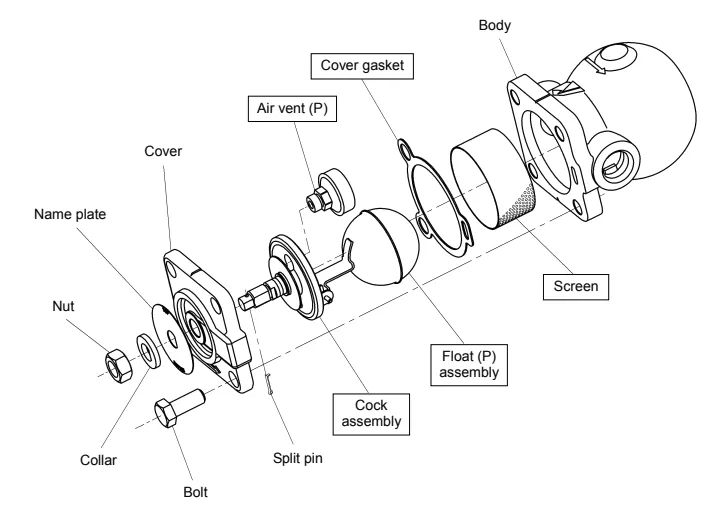Features:
Size 1" to 2" BSPT
Body Ductile Iron
Pressure Range 0.1 to 21 BAR
Temperature 0 to 220°C
| Application | Steam Condensate |
|---|---|
| Type | Float Trap |
| Working Pressure | 0.1 to 5 Bar | 0.1 to 10 Bar | 0.1 to 21 Bar |
| Temperature | 0°C to 220°C |
| Connection | BSPT (ISO 7.1) |
| Body | Ductile cast iron |
| Valve & Seat | Stainless Steel (Heat treated) |
| Float | Stainless Steel (Heat treated) |
Maximum Continous Discharge Capacity Chart


| Nominal Size | d | L | A | A1 | H | Kg |
|---|---|---|---|---|---|---|
| 25 | Rc 1" | 190 | 244 | 147 | 186 | 9.9 |
| 32 | Rc 1 1/4" | 190 | 244 | 147 | 186 | 10 |
| 40 | 1 1/2" | 205 | 244 | 147 | 186 | 10.2 |
| 50 | 2" | 220 | 244 | 147 | 186 | 10.5 |
All dimensions in mm unless shown otherwise.

Size 1" to 2" BSPT
Body Ductile Iron
Pressure Range 0.1 to 21 BAR
Temperature 0 to 220°C
What is a Float Steam Trap?
A Float type steam trap is a mechanical steam trap that utilises an automatic valve to discharge condensate (water) without the loss of live steam. It functions by having the ability to differentiate between Steam, Air/Gas and Condensate via the difference in density between Steam as a gas & Condensate a liquid. The intention is to discharge condensate and hold back steam.
How does a Float Trap work?
Float Type Steam Traps are commonly referred to as a Float & Thermostatic mechanical type. Most, utilise a float attached to a lever with a fulcrum and pin for operation. When condensate reaches the trap it will cause the float to rise, allowing the valve which is attached to the other end of the lever, to move off its seat and release condensate. The float becomes buoyant in the denser condensate liquid, allowing condensate to pass through the trap and less buoyant in any gas (Steam) preventing steam from leaving the system. This function causes the valve mechanism to open and close as required. The valve outlet is always surrounded by a waterseal so no steam or air can pass through. Modern traps also use a built in thermostatic air vent, which can detect the difference in temperature between the hot steam and the cooler air, this allows air and other gases to pass freely, especially on start up. The Float & Thermostatic Steam Trap works efficiently on both light and heavy condensate loads. Discharge capacity is high and continuous, when required, ensuring maximum heat transfer and equally efficient on light loads. One drop in one drop out. They discharge condensate as soon as it is formed, regardless of changes in steam pressure. Float traps are very quiet in operation with typically a continuous modulating type discharge. Ball float steam traps are the best choice for draining any process/heat transfer plant, especially with automatic modulating temperature control. As with most mechanical Steam Traps the Float Type Steam Trap will be available with a selection of main valve internal assemblies to match operating pressures and required flow rates. An integral air vent is normally fitted as standard and a steam lock release can also be utilised in some cases, while some also have multi directional installation ability. They are a very versatile steam trap.
How long will my Float Steam Trap last?
This really depends upon the environment and the quality of your steam that the steam trap operates with. The installation of strainers is highly recommended to reduce the amount of dirt and other impurities from entering the steam trap internals. A correctly selected and sized Float type Steam Trap with a good maintenance regime, should perform for many years. Obviously it should be installed in accordance with the manufacturer's recommendations and it is highly recommended that regular inspection of the steam trap is carried out at least once a year and if found to be faulty it should be cleaned and or repaired as required. This will give the valve the best opportunity to continually operate satisfactorily for many years. When a steam trap does fail it can lead to a loss of production and or a waste of energy through leaking steam, fuel bills will increase. Depending on the quality of your steam, It is a rule of thumb that 10/15% of steam traps will fail annually, so it is vitally important that regular checks for correct operation are carried out often.
How do I install a Float Trap?
It is important when selecting and sizing any type of steam trap, that certain criteria is met. Such as the operating pressure/temperature, the duty required, the application, back pressure etc. There is no such thing as a universal trap or one size fits all; each trap must be selected to suit the application. Steam Traps should always be installed in accordance with the manufacturers recommendations and in accordance with good steam fitting practice. In Particular, always insure; correct direction of flow, correct orientation, leave clear access for general maintenance and repairs.They can have various end connections such as flanged, threaded, socket weld etc so installation will need to take this into account. Always take into consideration the discharge of a steam trap and if it is going to the atmosphere, ensure it is discharging to a safe place, not to cause damage to the environment or injury to animals and humans. Where practical, it is highly recommended that all condensate be returned to the boiler due to the high level of energy stored within the hot condensate. Steam condensate is also very clean/pure and will require less chemical treatment for boiler feedwater, another cost saving reason to return to the boiler.
What are typical uses of a Float Steam Trap?
When saturated steam gives up its energy to any colder surface it condenses and condensate is formed. This condensate is usually a hindrance to heat transfer efficiency and a potential danger to the safe operation of any steam system in general. There are many applications for steam traps and many varied reasons why and where a steam trap may be required for any particular application. It is vitally important that those charged with selecting, sizing and installing a steam trap are also very familiar with steam and condensate system design and good steam fitting practice. The results of poor selection and installation can be catastrophic. Property has been damaged and humans have been injured and even killed as a result of poor condensate drainage from a steam system. Typical uses for Float Type steam traps are in applications where efficient heat transfer is required for production processes, applications with widely fluctuating loads, draining Steam Separators for protection to pressure and temperature control valves etc, shell & tube and plate and frame heat exchanger drainage, steam coil drainage, tanks & vats, Humidifiers, Air heater coils, Mash tanks, Steam Kettles, Calandrias etc etc. If you are unsure please contact us for more detailed sizing and selection support.
How long will my product take to get to me?
This depends upon where you are based and the freight method chosen. If the express freight option is selected it is usually next day delivery to metropolitan areas in Australia for under 5kg. If free freight has been selected it will go by road freight which can be anywhere from 1 to 10 days depending upon your location. It usually averages 3 days.
What warranty do I get?
All of our products come standard with a 12 month warranty. The good news is we have very strict quality controls and all steam traps that leave our warehouse are tested (full material and testing certificates are available) and inspected so there are rarely any issues.

Size 1" to 2" BSPT
Body Ductile Iron
Pressure Range 0.1 to 21 BAR
Temperature 0 to 220°C

| Application | Steam Condensate |
|---|---|
| Type | Float Trap |
| Working Pressure | 0.1 to 5 Bar | 0.1 to 10 Bar | 0.1 to 21 Bar |
| Temperature | 0°C to 220°C |
| Connection | BSPT (ISO 7.1) |
| Body | Ductile cast iron |
| Valve & Seat | Stainless Steel (Heat treated) |
| Float | Stainless Steel (Heat treated) |
Maximum Continous Discharge Capacity Chart


| Nominal Size | d | L | A | A1 | H | Kg |
|---|---|---|---|---|---|---|
| 25 | Rc 1" | 190 | 244 | 147 | 186 | 9.9 |
| 32 | Rc 1 1/4" | 190 | 244 | 147 | 186 | 10 |
| 40 | 1 1/2" | 205 | 244 | 147 | 186 | 10.2 |
| 50 | 2" | 220 | 244 | 147 | 186 | 10.5 |
All dimensions in mm unless shown otherwise.
